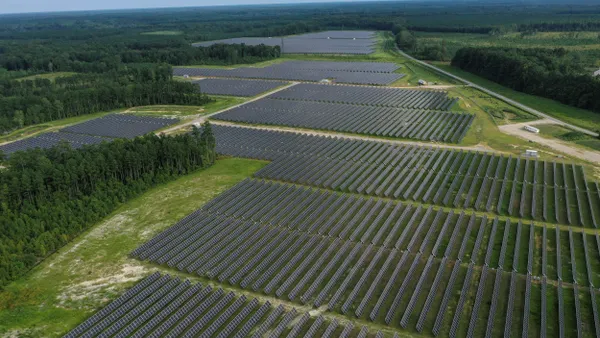Dive Brief:
-
Public Service Company of New Mexico's (PNM) latest integrated resource plan (IRP) lays out a 20-year strategy for achieving its vision of zero carbon emissions by 2040.
-
This is the first roadmap the utility filed since announcing a clean energy goal and an accelerated exit from coal generation, which PNM director of integrated resource planning Nick Phillips said is set to take place by 2024. The IRP lays out several potential paths to full decarbonization by 2040 as PNM retires its gas generators over the course of the late 2020s and the 2030s.
-
However, environmental groups say the plan does not actually achieve true decarbonization, with the Sierra Club criticizing PNM's decision to sell its interests in the Four Corners coal plant. The sale, according to senior attorney Matthew Gerhart, may serve to prolong the plant's operations.
Dive Insight:
According to PNM, the utility's latest IRP charts a course to zero emissions by 2040 that begins with the initial step of eliminating coal years earlier than the utility thought would be possible. But the Sierra Club sees things differently, arguing the planned sale of PNM's shares of the Four Corners plant simply shifts those carbon emissions from New Mexico's largest electricity provider to someone else.
PNM had originally assumed they were locked into their share of Four Corners until at least 2031, and when they began to explore decarbonization they made sure to stress that the utility would continue to source coal-fired power through that date, according to Ray Sandoval, a spokesperson for PNM. But the utility is committed to eliminating carbon emissions by 2040, Sandoval said, so when the opportunity arose for PNM to transfer its share of the plant to the Navajo Transitional Energy Company (NTEC), they jumped at the chance.
Transferring the shares to NTEC will not only allow PNM to eliminate coal from its portfolio by 2024, but will also save PNM customers anywhere from $20-$100 million and will provide the Navajo community with more of an economic "glide slope" following the transfer.
However, Gerhart noted that PNM could have remained a shareholder at the plant and voted for its closure, had the utility not agreed to the transfer terms. The terms of the transfer require PNM to continue operating the plant until the transfer occurs, according to him.
"They're getting out of Four Corners under the guise of getting out of coal," Gerhart said, "but the way they have chosen to do that will keep the largest source of carbon emissions in New Mexico open."
Gerhart also criticized PNM for running recent advertisements claiming the company is taking steps to be coal free, when "what PNM is really proposing is to transfer its interests to another entity."
At the heart of the conflict between the Sierra Club and PNM is a question of whether decarbonizing utilities are responsible for emissions beyond their generation fleet, according to Pat O'Connell, senior clean energy policy analyst for Western Resource Advocates. Prior to joining the WRA, O'Connell was PNM's director of planning and resources, helping write the utility's previous IRP filed in 2017.
"PNM has framed this plan around their own generation fleet," O'Connell said. "And so, they're decarbonizing their generation fleet, but they're not decarbonizing the environment."
O'Connell said he did not believe the IRP accomplished the stated goal of planning for full decarbonization. While it might result in the decarbonization of PNM's generation assets, he said it did not take into account emissions such as those produced by the company's vehicle fleet.
"This is a step that has to be taken, and it's an important first step," O'Connell said. "But I give it an 'incomplete.'"
After closing the San Juan coal-fired power plant in 2022 and exiting Four Corners in 2024, more than two-thirds of PNM's energy will come from renewable energy, according to the 2020 IRP. That part of the plan, PNM's Phillips said, is already in motion.
The utility's parent company, PNM Resources, also announced a merger with AVANGRID. If approved, the merger would create opportunities to access lower financing costs and more easily replace capacity from the coal plants.
From there, PNM has several paths forward as it retires its gas plants. PNM could source its power from a mix of solar and long-term storage options, including batteries, pumped storage, or other options. Or they could build out additional wind resources and bring in renewable resources sited farther away with new transmission lines.
PNM might replace older gas turbines with newer models that could be converted to hydrogen or another carbon-free fuel at some future date, Phillips said.
O'Connell criticized some of the long-term options proposed by PNM's IRP for their over-reliance on "zero carbon fuels" that aren't available yet.
While some of the paths in the IRP would rely on technology that is not yet mature, Phillips said PNM was confident that, if necessary, they could reach their 2040 coal with existing technology.
"If we were only given the technology we know about today, we could make it work and still be carbon free by 2040," he said. "It does present certain risks, and the things that could alleviate those risks would be non-carbon emitting fuels or longer duration storage."













